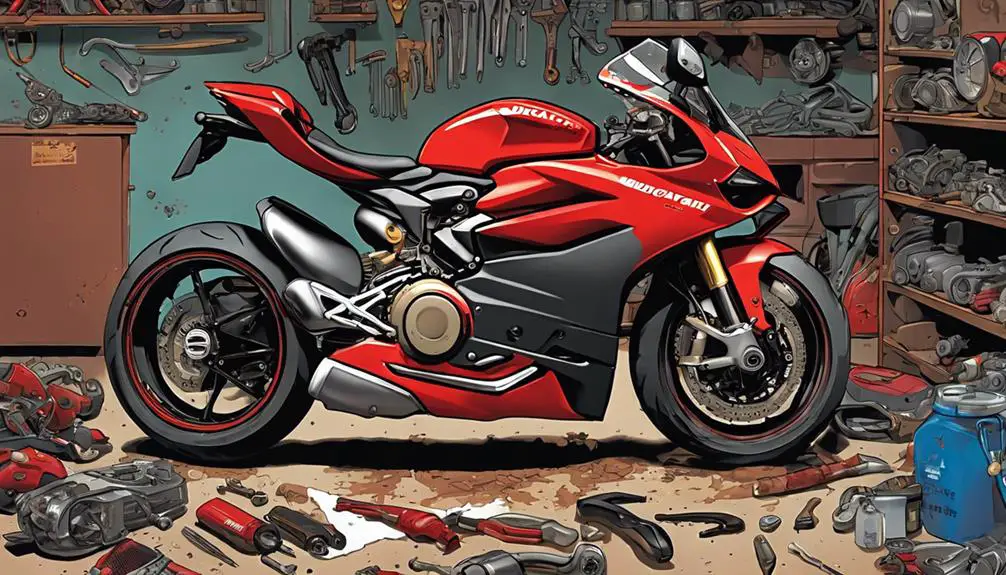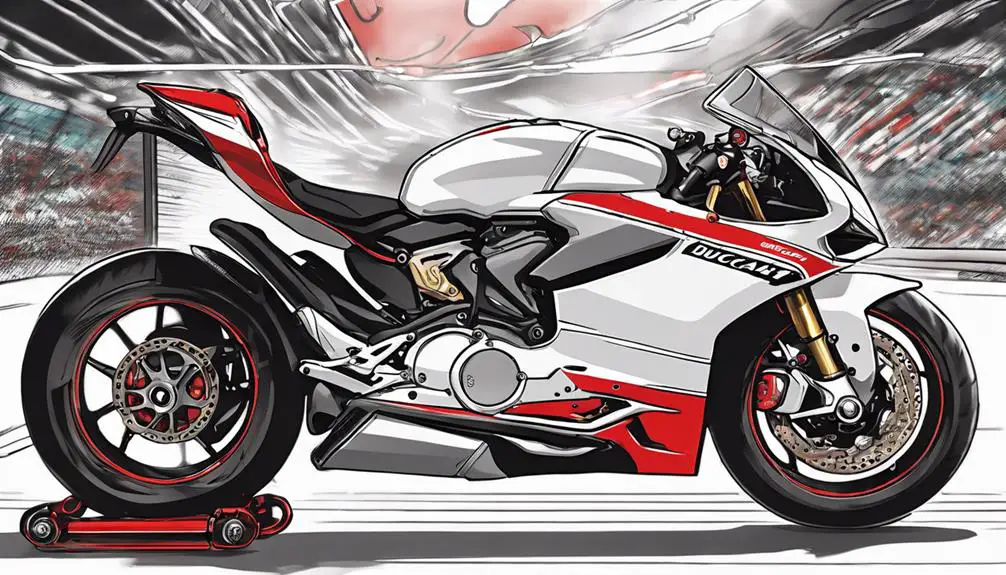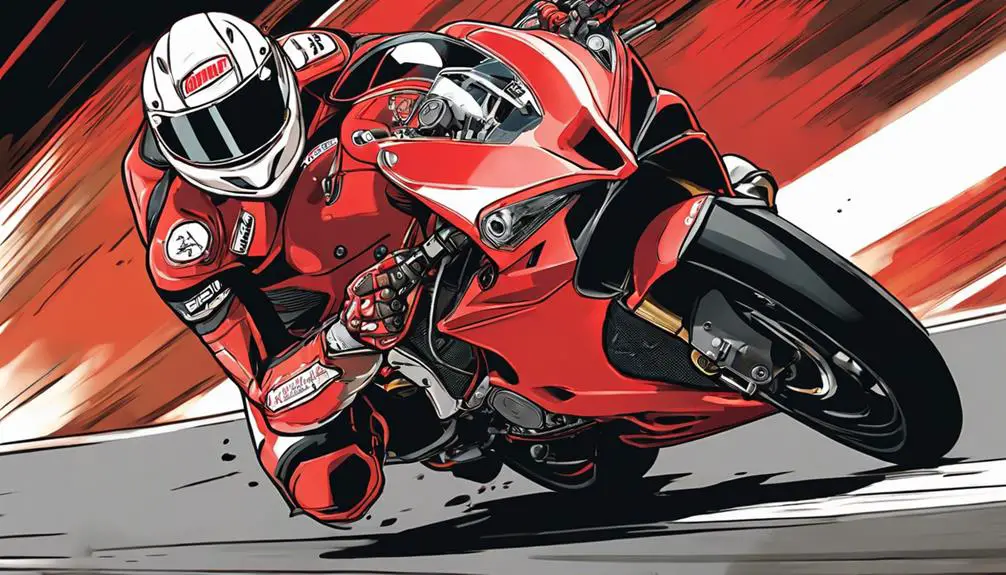You might think that the Panigale's performance outweighs its issues, but many riders still encounter significant challenges. From mechanical complexities to electrical system quirks, these factors can dampen your riding experience. Riders often report clutch slippage and suspension stiffness, while maintenance can feel like an intimidating task due to the bike's sophisticated design. As you consider these elements, it's crucial to explore how they impact not just performance but also your overall satisfaction with the ride. What exactly are the underlying causes of these frustrations?
Key Takeaways
- Many riders experience clutch slippage and chain tension problems, impacting acceleration and control during rides.
- Electrical system challenges, including battery drain and ECU malfunctions, disrupt performance and reliability.
- Suspension rigidity and lack of feedback can hinder handling and overall ride quality, especially on bumpy roads.
- Complex engine design and specialized maintenance requirements make routine servicing difficult for owners without proper tools.
Common Mechanical Issues

Many Panigale riders encounter mechanical issues that can affect performance and safety. You might notice problems like clutch slippage, which can lead to poor acceleration and reduced control over your bike. It's essential to address this promptly; otherwise, your riding experience could turn into a struggle rather than the exhilarating adventure you crave.
Another common issue is the chain tension. If it's too loose or too tight, it can cause premature wear and hinder your bike's handling. You'll want to regularly check the tension to maintain that liberating ride you love.
Additionally, some riders report issues with the brakes, especially if they feel spongy or unresponsive. This can seriously compromise your safety, so don't ignore it.
Lastly, pay attention to your suspension settings. If it's not dialed in correctly, you might find yourself struggling through corners instead of gliding effortlessly. Regular maintenance checks can help you catch these problems before they escalate, ensuring your Panigale remains the beast you desire.
Embrace the freedom of the open road without the worry of mechanical setbacks—your ride should always empower you, not hold you back.
Electrical System Challenges
When riding your Panigale, you might encounter some frustrating electrical system challenges.
Common failures, limitations in diagnostic tools, and vulnerabilities in the wiring harness can all impact your experience.
Let's take a closer look at these issues and how they affect your ride.
Common Electrical Failures
Electrical issues in the Panigale often manifest as intermittent failures, leaving riders frustrated and searching for solutions. You might find your bike's dashboard flickering or the lights dimming unexpectedly, creating an unsettling experience. These symptoms can point to underlying problems like faulty wiring or loose connections, which can rob you of that exhilarating ride.
One common issue is the battery drain, where your bike refuses to start after a brief rest. This can disrupt your plans and cloud your passion for freedom on the road. Another frequent challenge involves the ECU malfunctioning, which can lead to erratic performance and even cause the engine to stall unexpectedly. You deserve a ride without the nagging worry of electrical failures.
To tackle these issues, you'll want to regularly check all connections and verify your battery is in good shape. Keeping your electrical components clean and well-maintained can help prevent these nuisances.
Diagnostic Tool Limitations
Diagnostic tools can sometimes fall short in diagnosing the complex electrical issues of the Panigale, leaving you grappling with uncertainty about your bike's performance. You might plug in the diagnostic tool only to find it struggling to pinpoint the root cause of an error. The intricacies of the Panigale's electrical system can overwhelm even the most advanced diagnostic equipment, making it hard to trust the readings you get.
When you rely on these tools, you may feel a sense of frustration as they don't always provide clear guidance. This ambiguity can lead to unnecessary expenses and time spent on repairs that mightn't address the real problem. You want freedom on the road, but the limitations of these diagnostic tools can keep you shackled, forcing you to wrestle with vague alerts and ambiguous warning lights.
Moreover, understanding your bike's electrical system becomes essential. It empowers you to make informed decisions when addressing issues, ensuring you don't feel lost in a sea of uncertainty. By embracing this knowledge, you can liberate yourself from the constraints posed by inadequate diagnostic tools and take control of your riding experience.
Wiring Harness Vulnerabilities
Often overlooked, the wiring harness in the Panigale can present significant vulnerabilities that impact the bike's overall electrical performance. You mightn't realize it, but this complex network of wires connects critical components, and any wear or damage can lead to frustrating electrical issues.
Over time, vibrations and heat can cause the insulation on these wires to wear down, creating the perfect conditions for shorts and failures. If you're riding with a compromised harness, you could face unexpected shutdowns or erratic behavior from your bike. This isn't just an inconvenience; it limits your freedom on the road and can lead to unsafe situations.
To liberate yourself from these frustrations, consider inspecting your wiring harness regularly. Look for signs of wear, such as fraying or exposed wires. If you spot any issues, addressing them promptly can prevent larger electrical failures down the line.
In the pursuit of a smooth ride, don't underestimate the importance of a healthy wiring harness. By being proactive, you empower yourself to enjoy the thrill of riding without the constant worry of electrical problems.
Suspension and Handling Problems

Many riders experience frustration with the Panigale's suspension and handling, leading to concerns about its overall performance on various terrains. You might find the stock suspension too stiff, making it challenging to navigate bumpy roads or twisty paths. This rigidity can rob you of the freedom to truly connect with the ride. When you push the limits, you may notice a lack of feedback from the front end, which can feel unsettling, especially in cornering situations.
If you're looking to release the full potential of the Panigale, adjusting the suspension settings is vital. However, the process can be intimidating, and not everyone feels equipped to tackle it. You want a bike that feels like an extension of yourself, not one that holds you back. Many riders opt for aftermarket solutions, but this can add layers of complexity and expense.
Ultimately, achieving a balance between comfort and responsiveness is essential for a liberating riding experience. Take the time to explore your options, and don't hesitate to reach out to fellow riders or professionals who can assist you in fine-tuning your setup. Your journey deserves to be exhilarating, not frustrating.
Maintenance and Service Difficulties
When it comes to maintaining your Panigale, you'll quickly notice the need for specialized tools and expertise.
The complex engine design can complicate routine service, making it a challenge for even seasoned riders.
Plus, finding a qualified service provider can be difficult, leaving you feeling stuck when issues arise.
Specialized Tools Required
Specialized tools are essential for maintaining the Panigale, as standard equipment often falls short of meeting its unique service requirements. If you're a rider seeking the freedom that comes with owning a high-performance machine, you need to embrace the importance of having the right tools at your disposal.
Without them, tackling even basic maintenance can feel like an uphill battle, and you might find yourself trapped in a cycle of frustration.
Investing in specialized tools not only empowers you to perform routine tasks but also reveals the potential to engage with your bike on a deeper level. Think about it: whether you're adjusting the suspension or replacing the oil, having the right gear makes all the difference.
You're not just a rider; you're a custodian of a powerful beast, and that requires commitment.
Complex Engine Design
The Panigale's complex engine design poses significant maintenance and service challenges that can intimidate even experienced riders. You might find yourself overwhelmed by the intricate components and advanced technologies packed into this machine. Each part requires a specific approach, and one misstep can lead to costly repairs or reduced performance.
When you attempt to service the engine yourself, you'll quickly realize that understanding the nuances of its design is essential. The finely-tuned elements, like the desmodromic valve system, demand precision and expertise. Relying on generic manuals or DIY videos can lead you astray, making the task feel impossible.
Additionally, the engine's tight packaging can make access to vital components a real headache. You may end up spending more time contorting your body than actually performing the maintenance. This complexity can feel like a barrier rather than a pathway to freedom, which is what riding should be about.
You deserve the joy of seamless service, not the stress of confusion. Embracing the Panigale means committing to understanding its sophisticated design, but this can be a challenging journey for many riders. Equip yourself with knowledge and support to navigate these challenges effectively.
Limited Service Availability
Finding qualified technicians for your Panigale can be a challenging task, as limited service availability often leaves riders struggling to get the maintenance they need. You may find that local dealerships are few and far between, making it tough to schedule necessary servicing without long waits. This lack of access can lead to frustration, especially when your bike requires specialized attention that only certain technicians can provide.
Moreover, the intricate design of the Panigale demands a level of expertise that not every mechanic possesses. You might end up searching far and wide, only to discover that many are unfamiliar with the unique systems of your beloved machine. This can't only delay essential maintenance but also put your bike's performance at risk.
As a rider who values freedom, you shouldn't have to feel bound by limited service options. To liberate yourself from this dilemma, consider connecting with fellow Panigale enthusiasts online. They can point you towards reputable technicians or even share DIY tips, empowering you to take control of your bike's care.
Ultimately, it's about ensuring your Panigale runs smoothly so you can enjoy the ride without worry.
Performance-Related Concerns

Many riders report issues with acceleration and handling that can hinder the Panigale's overall performance. You might find that the bike doesn't respond as quickly as you'd like when you twist the throttle, leaving you feeling frustrated during those exhilarating rides. This lack of responsiveness can be particularly noticeable in tight corners or during aggressive maneuvers, where precision is key.
Additionally, the handling can feel less intuitive than you'd expect from a machine designed for speed. You may struggle with stability at higher speeds or find it challenging to maintain your line through a bend. This can take away from the sense of freedom and confidence you crave when riding.
Even if you're a seasoned rider, these performance-related concerns can impact your enjoyment and connection with the road. You deserve a bike that empowers you, releasing your spirit as you tackle each twist and turn.
It's crucial to stay aware of these issues and seek solutions, ensuring your Panigale truly delivers on its promise of exhilarating performance. After all, riding should be about liberation, not limitations.
Owner Feedback and Experiences
Riders often share a mix of exhilaration and frustration when it comes to their experiences with the Panigale, highlighting both the bike's thrilling capabilities and the challenges they face on the road. You crave freedom and the rush of wind in your face, but sometimes the Panigale can throw you for a loop.
Here are three common feedback points from owners:
- Power Delivery: While the acceleration is exhilarating, some riders find it challenging to manage at low speeds or in tight corners.
- Comfort Level: Long rides can become a test of endurance, as the aggressive riding position isn't always kind to your back after a few hours.
- Maintenance Costs: You love the bike, but the upkeep can be pricey and time-consuming, leading to some riders feeling tethered rather than liberated.
Despite these concerns, many riders wouldn't trade their Panigale for anything else. The connection to the machine and the rush it brings often outweighs the setbacks.
Embrace the journey, and you might just find that the challenges only enhance the ride.
Frequently Asked Questions
What Is the Average Lifespan of a Panigale's Engine?
The average lifespan of a Panigale's engine typically ranges from 20,000 to 30,000 miles, depending on how you ride and maintain it.
If you're diligent with regular servicing and avoid harsh treatment, you might even stretch that lifespan further.
Keep an eye on the oil changes and tune-ups to guarantee your engine's running smoothly.
How Does Riding Style Affect Panigale Performance?
Your riding style's like a secret handshake with your Panigale; get it wrong, and it's all awkward glances.
If you're smooth and fluid, you'll feel like a rock star, cruising through curves. But if you're all jerky and tense, the bike responds like a sulky teenager.
So, embrace that freedom! Let your instincts guide you, and you'll reveal the true potential of your ride.
After all, it's all about that exhilarating connection, isn't it?
Are There Aftermarket Modifications for Better Reliability?
Absolutely, there are several aftermarket modifications you can consider for better reliability.
Upgrading the cooling system can help manage engine temperatures, while installing a high-quality air filter can improve airflow.
You might also look into enhanced suspension components for better stability.
Don't forget about a reliable battery and upgraded brake lines for safety.
These modifications not only boost performance but also enhance your overall riding experience, giving you the freedom to enjoy the road.
What Riding Conditions Are Best for a Panigale?
For your Panigale, the best riding conditions are dry, smooth roads with plenty of twisties.
You'll enjoy the bike's performance in moderate temperatures, where grip and handling shine.
Avoid heavy rain and extreme cold, as they can make riding tricky.
Embrace the open roads during clear days, allowing you to release the bike's full potential.
When you ride with confidence, you'll feel that exhilarating freedom that only a Panigale can provide.
How Does the Panigale Compare to Other Sportbikes?
You'd think the Panigale would be the ultimate sportbike, but it's more like a diva on wheels.
While it dazzles with its power and sleek design, it often demands respect and precision.
Compared to other sportbikes, its aggressive stance and advanced electronics can intimidate the uninitiated.
Yet, once you embrace its quirks, it offers a thrilling ride that few can match, proving that liberation often comes with a touch of chaos.
Conclusion
In the world of superbikes, the Panigale can feel like a double-edged sword—its stunning performance comes with a catch.
While it offers an exhilarating ride, the mechanical complexities and maintenance challenges can turn your dream bike into a source of frustration.
Understanding these issues can help you navigate the Panigale experience with confidence.
After all, every ride should feel like freedom, not a battle against your machine.
Embrace the journey, and keep your ride smooth and enjoyable!